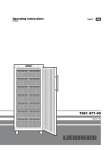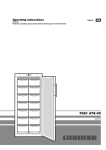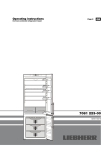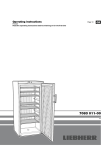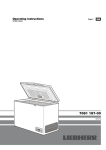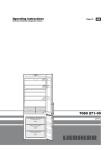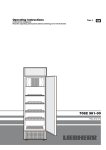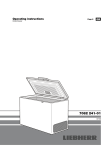Download Liebherr GG 5210 freezer
Transcript
Operating instructions Freezer Read the operating instructions before switching on for the first time Page 6 GB 7081 477-00 GG 52 1110 Disposal notes • Keep packaging materials away from children - polythene sheets and bags can cause suffocation! • Please return the packaging to an official collection point. Your old appliance: This contains some reusable materials and should be disposed of properly - not simply with unsorted household refuse. • Discarded appliances should be disabled: Remove the plug, cut through the connection cable and render the catch unusable so that children cannot become trapped inside. • Ensure that the refrigerant circuit is not damaged when the appliance that is no longer needed is taken away for disposal. • Details of the refrigerant can be found on the type plate. • Appliances which are no longer needed must be disposed of in a professional and appropriate way, in accordance with the current local regulations and laws. Range of appliance use The appliance is suited only for cooling food. In the case of commercial food cooling, the pertinent statutory regulations have to be observed. The appliance is not suited for storing and cooling pharmaceuticals, blood plasma, laboratory preparations or similar substances and products subject to the Medical Devices Directive 2007/47/EC. Any misuse of the appliance may result in damage to or spoilage of the stored goods. Furthermore, the appliance is unsuited for use in areas exposed to an explosion hazard. Description of appliance and equipment Lock Operating elements Safety instructions and warnings • To prevent injury or damage to the unit, the appliance should be unpacked and set up by two people. • In the event that the appliance is damaged on delivery, contact the supplier immediately before connecting to the mains. • To guarantee safe operation, ensure that the appliance is set up and connected as described in these operating instructions. • Disconnect the appliance from the mains if any fault occurs. Pull out the plug, switch off or remove the fuse. • When disconnecting the appliance, pull on the plug, not on the cable. • Any repairs and work on the appliance should only be carried out by the customer service department, as unauthorised work could prove highly dangerous for the user. The same applies to changing the mains power cable. • Do not allow naked flames or ignition sources to enter the appliance. When transporting and cleaning the appliance ensure that the refrigerant circuit is not damaged. In the event of damage, make sure that there are no ignition sources nearby and keep the room well ventilated. • Do not stand on the plinth, drawers or doors or use them to support anything else. • This appliance is not intended for use by persons (including children) with reduced physical, sensory or mental capabilities or lack of experience and knowledge unless they have been given initial supervision or instruction concerning use of the appliance by a person responsible for their safety. Children should be supervised to ensure that they do not play with the appliance. • Avoid prolonged skin contact with cold surfaces or chilled/frozen food. This could cause pain, numbness and frostbite. In the case of prolonged skin contact, protective measures should be taken, e.g. gloves should be worn. • Do not eat ice cream, particulary ice lollies or ice cubes, immediately after taking them from the freezer compartment as there is a risk of "burning" because of the very cold temperatures. • Do not consume food which has been stored for too long, as it could cause food poisoning. • Do not store explosives or sprays using combustible propellants such as butane, propane, pentane etc. in the appliance. Electrical components might cause leaking gas to ignite. You may identify such sprays by the printed contents or a flame symbol. • Do not use electrical appliances inside the appliance. Baskets Type plate Adjustable height feet 6 • If you have a lockable appliance, do not keep the key near the appliance or within reach of children. • The appliance is designed for use in enclosed areas. Do not operate the appliance outdoors or in areas where it is exposed to splash water or damp conditions. Climate rating The appliance is set to operate within specific ambient temperature limits according to its climate rating. These temperature limits should not be exceeded. The correct climate rating for your appliance is indicated on the type plate. Climate rating Operating and control elements GB Ambient temperatures SN N ST T + 10° to + 32 °C + 16° to + 32 °C + 16° to + 38 °C + 16° to + 43 °C Setting up • Avoid positioning the appliance in direct sunlight or near cookers, radiators and similar sources of heat. • The floor on which the appliance stands should be horizontal and level. Compensate for uneven floors with the adjustable feet. The appliance can be placed with its back flush to the wall. • The ventilation grilles should not be obstructed. Always ensure that there is good ventilation and that the outward flowing air is able to escape. • Do not place heat-emitting appliances, e.g. microwave oven, toaster, etc., on top of the freezer. • Standard EN 378 specifies that the room in which you install your appliance must have a volume of 1 m3 per 8 g of R 290 refrigerant used in the appliance, so as to avoid the formation of inflammable gas/air mixtures in the room where the appliance is located in the event of a leak in the refrigerant circuit. The quantity of refrigerant used in your appliance is indicated on the type plate on the inside of the appliance. • Do not connect the appliance to the supply with other equipment using an extension cable - risk of overheating. • Always install the appliance directly against the wall. Dimensions A= 1864 mm B= 750 mm C= 750 mm D= 1447 mm E= 790 mm 1 Temperature display 2 Temperature buttons 3 On/Off button 4 Audible warning on/off button 5 Child-proof lock Switching the appliance on and off Switching on: Press the ON / OFF button so that the temperature display lights up/flashes. When the appliance is switched on for the first time and while it is still warm, the display will contain dashes until the temperature falls below 0°C. Switching off: Press the ON / OFF button for approx. two seconds so that the temperature display goes out. Setting the temperature To reduce the temperature: Press the DOWN button. To increase the temperature: Press the UP button. - While you are entering the temperature, the set temperature will flash on the display. - When you press the temperature setting buttons for the first time, the most recent setting is displayed. - You can change the settings in increments of 1°C by briefly pressing the buttons again. - The electronic controls will switch over automatically about 5 seconds after the last time you pressed the button, and the actual temperature in the freezer will be displayed. - The temperature can be set at between -14°C and -28°C. If F 3 appears in the display, the appliance has a fault. Consult the customer service department indicating the fault number displayed. Audible warning signal The appliance is equipped with an alarm function. Connecting to the mains Power supply (a.c.) and voltage at the operating point must comply with the details on the type plate. The socket must be fused with a 10 A fuse or higher, it must be away from the rear of the appliance and must be easily accessible. Connect the appliance with a properly earthed fused plug and socket only. Storage The appliance is suitable for storing ice cream and ready-frozen foods. Audible door alarm: This sounds when the door has been left open for longer than about 180 seconds. Press the audible warning on/ off button to cancel the alarm. The alarm switches back to standby when the door is shut. Audible/visual temperature alarm: It sounds when it is not cold enough in the freezer compartment. The temperature display will also flash; The audible warning device is switched off by pressing the "ALARM" button. The temperature display will continue to flash until the cause of the alarm has been rectified. This can be caused by: • the freezer door being left open for a long time, allowing warm ambient air to enter; • a long power failure; • a fault in the appliance. In each case, make sure food has not defrosted or perished. 7 Additional functions Cleaning The child-proof lock is designed to protect the appliance from being switched off and the temperature setting from being changed accidentally. Clean the inside, equipment parts and outer walls with lukewarm water and a little detergent. Do not use abrasive or acid cleaners or chemical solvents. In set-up mode you can set the child-proof lock and adjust the brightness of the display. Activating set-up mode: • Press the Alarm button for approx. 5 secs - the display shows c for child-proof lock. Note: The value to be altered flashes. • Select the required function by pressing the Up/Down button: c = child-proof lock, h = display brightness. • Now select/acknowledge the function by pressing the Alarm button briefly: >For c = child-proof lock, press the Up/Down button to select c1 = child-proof lock on or c0 = child-proof lock off and acknowledge with the Alarm button. When the symbol is lit, the child-proof lock is activated. >For h = brightness, press the Up/Down button to select h1 = minimum to h5 = maximum brightness and acknowledge with the Alarm button. Exiting set-up mode: • Exit the set-up mode by pressing the On/Off button; after 2 min. the electronic system switches over automatically. The normal operating mode is activated again. Safety lock The lock is equipped with a safety mechanism. Locking the appliance: • Insert the key as shown by arrow 1. • Turn the key 90°. To unlock the appliance, the same procedure must be repeated in the same order. Before cleaning always switch off the appliance. Pull out the mains plug or remove/unscrew the fuse. Do not use steam cleaners because of the risk of injury and damage. • Ensure that no cleaning water penetrates into the electrical components or ventilation grille. • Dry all parts well with a cloth. • The dust should be removed from the refrigeration unit and heat exchanger - metal grid at the back of the appliance - once a year. • Do not damage or remove the type plate on the inside of the appliance. It is very important for servicing purposes. • Use a commercially available stainless-steel cleaning agent for stainless-steel appliances. - In order to achieve best possible protection, apply a stainless-steel care agent uniformly in grinding direction after cleaning. Points which are darker at the start and a more intensive coloration of the stainless-steel surface are normal. - Do not use abrasive sponges or scourers, do not use concentrated cleaning agents and never use cleaning agents containing sand, chloride or acid or chemical solvents, as these would damage the surfaces and could cause corrosion. Malfunctions You may be able to rectify the following faults by checking the possible causes yourself: • Appliance does not function: the control lamps are not lit. –Is the appliance switched on? –Is the plug correctly fitted in the mains socket? –Is the socket fuse intact? • The temperature is not low enough: –Is the temperature setting correct (see "Setting the temperature")? –Have excessive amounts of fresh food been placed in the appliance? – Does the separately installed thermometer show the correct reading? – Is the ventilation system working properly? – Is the appliance set up too close to a heat source? If none of the above causes apply and you cannot rectify the fault yourself, contact the nearest customer ser vice department stating the type of appliance 1, service number 2 and appliance number 3 as indicated on the type plate. Defrosting After a longer period of operation a layer of frost or ice can build up on the cooling plates in the freezer compartment. This will increase the energy consumption of the freezer. The cooling plates should therefor be defrosted regularly. • Switch the appliance off to defrost. Pull out the mains plug. • Wrap the frozen food in paper or blankets and store in a cool place. • To speed up the defrosting process put a saucepan of hot but not boiling water on one of the cooling elements. • Leave the door of the appliance open while defrosting. After defrosting mop up the remaining water and clean the appliance. Do not use any mechanical devices or other artificial aids for defrosting other than those recommended by the manufacturer. 8 Shutting your appliance down If your appliance is to be shut down for any length of time, switch it off and disconnect the plug or remove the fuse. Clean the appliance and leave the door open in order to prevent unpleasant smells. The appliance complies with the relevant safety regulations and EC directives 2004/108/EC and 2006/95/EC. All types and models are subject to continuous improvement and the manufacturer therefore reserves the right to make modifica tions to the shape, equipment and technology. GB Changing over door hinges 1.Remove screw from lower hinge bracket. 6.Transfer lower hinge bracket and cover plate to the opposite side. 2.Lift door, tilt to the right and remove. 7.Locate door on upper pin. 3.Turn lower hinge pin through 180° and remove. 8.Tilt door inwards from the left. 4.Insert pin on the opposite side and turn through 180°. 5.Transfer upper hinge components to the opposite side. 9.Secure hinge pin with screw. 10. Transfer handle and plugs to the opposite side of the door. 9





